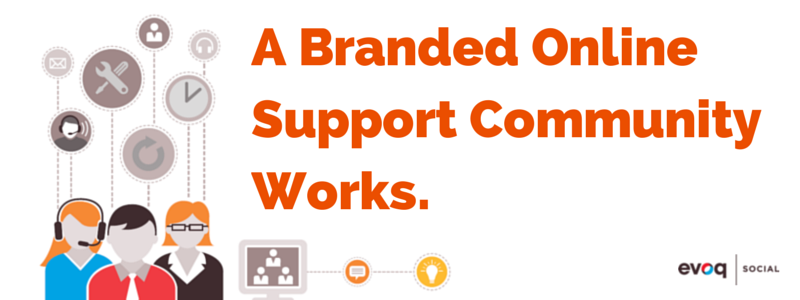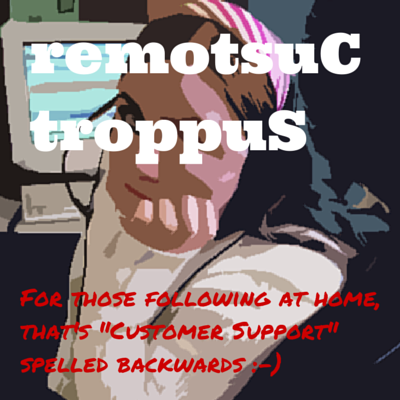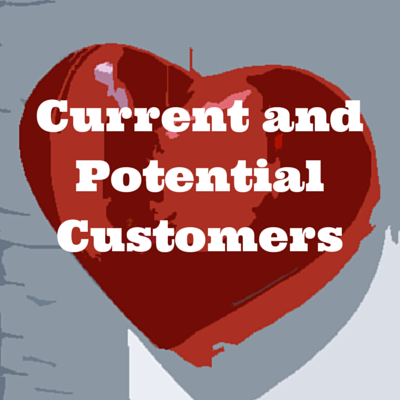
You’d think, after an
$83 billion lesson of customer defections and never-completed purchases, companies would get the point: their customer support is killing them.
It’s more than a sum zero game where, if your support is great, you’ll break even. The truth is that, if your support is great,
more than half of customers will buy again! You will do more than break even. You’ll get ahead.
But companies either refuse or are unable to understand how customer support plays into sales.
The Three Big Problems With Traditional Customer Support
1) Companies Get Customer Support Backwards

Companies often view customer support as the secondary thing, that action that happens after a successful sales cycle. It takes a back seat to the marketing and push to get a customer to buy.
Be honest. How often do you focus on getting the sale, and let things fall away afterwards?
Customer support isn’t at the tail end of the sales cycle, but it is present throughout the entire cycle. It shows up everywhere, and has a direct effect on sales.
Support happens before the first purchase.
Customers are coming into contact with your support team before they are even using your product. They’re seeing what happens on social media and in online reviews and discussions. They see what other customers are saying about both your product and your support, and they are watching how you respond.
In fact, that support experience is so important that
88 percent of your potential customers will avoid you if they get a whiff of anything negative about your customer service while researching you on social media.
The support they see before they buy helps them decide whether or not to buy.
Support happens after the purchase.
Once a customer buys, they are inevitably going to have questions. Customers aren’t always so good with the hand-off of something new, and after you’ve been wooing and pursuing them so ardently to get them to buy, it feels cold (and anger-inducing) to find themselves in an echo chamber when they try to get some help after they made the purchase from you.
The support they receive after they purchase helps them decide if they’ll keep, ask for a refund, or buy again.
Support happens before future purchases.
A current customer is not a guarantee. Your initial sale does not bring an end to pursuing their business. There are two things that will determine whether or not you’ll keep the customers you spent so much time and money getting: a great product, and your customer support.
It’s not enough to make a great product or to market it well. It’s not enough to close the sale. Customers want to know they won’t be left on their own after all of that is through, and that affects how they act before, after, and in the future.
Before the sale and after sale must match, experience for experience.
2) Companies Don’t Understand The Cost Of Bad Support

A poor customer support system is costing you. Big time.
Presale costs are wasted. You spent time and marketing money on customers to make the sale. When they leave and aren’t retained, the cost-per-customer rate is very high.
You are losing sales. Bad customer support, bad sales. This kind of loss is immediate and direct.
Support infrastructure is expensive. You are paying for software, apps, and support employees meant to keep all of this from happening. If the support is still sub-par, that’s money down the drain.
Directing your customers to costly and time-consuming email and phone customer support isn’t helping your bottom line, and it isn’t even what customers want. According to
studies done by Forrester Research, 63% of customers prefer online customer support.
They don’t want to talk to someone on the phone. They want to be able to go online and find an answer or get help themselves in a forum or by searching for information on your site.
The disconnect is that most companies pour their money into support methods that customers don’t want and
often lead to negative experiences. The customer support experience varies widely based on whether a customer called, emailed, chatted, or searched.
No one wants to be put on hold on the phone. No one wants to be transferred from one agent to the next. No one wants to navigate a confusing phone menu to save you time so the call gets where it is supposed to go. No one wants to wait a week for a support email to be returned.
3) Companies Create Support Systems That Don’t Scale
As your company grows, your customer support needs increase and scale with your company. Adding enough employees to cover a huge phone bank and email system isn’t cost effective.
I worked in a small start-up that had a small team early on. We saw our customer base grow rapidly. We focused on product development and marketing, but quickly realized that customer support was rapidly surpassing these areas. In fact, customer support was deeply connected to development and marketing. Customer support was helping us understand what to fix and develop, and it was indicating the best direction for marketing. While we didn’t have the budget to hire massive numbers of support staff, we knew we had to provide great customer service or risk losing our momentum.
What’s the solution to all of this? Is it really pouring lots of money into complex support systems and hiring more staff to man the phones?
A Branded Online Support Community Works
To avoid throwing away money and accidentally pushing customers out the door while still maintaining a feasible and scalable customer support system, you need to build a branded online support community. This is similar to an online forum, where both your support staff and your customers are actively involved in building living, organic help documentation.
Customers can ask (and answer) questions publicly, making them searchable by others. Your support staff can answer or direct customers to the answer elsewhere. Because it is clearly your brand and your forum, you clearly own the content that is created there. There are many
reasons to love a branded online support community.
Support Managers Love Them

With this kind of community, you can hit the bullseye on
key customer support concerns that any customer support manager is keen to see happen:
- Know your customers. Understand their needs and wants. Get their active feedback.
- Avoid customer support staff burnout. Keep your team from getting weary, and let them build their own brand of support.
- Avoid idle cycles for support staff. When support is slow, give your team a chance to build conversation and relationship with customers.
- Keep your knowledge base updated. Forget maintaining that behemoth, and let your customers help you keep things updated with their questions.
An online community meets all of those support concerns, and gives you additional benefits.
Find those invisible customers and problems.
With an online support community, you will discover customers (and problems) you might not have learned about otherwise. Customers conversing with customers behave differently than when conversing with brands.
You’ll also find that you have a treasure trove of information and content for your next case study or success story from what customers share in the community.
Motivate your support staff.
Unanswered questions in a support community create a racket. Customers are pretty good about letting you know when their question has been ignored too long. Additionally, customers can build up a rapport with people on your support staff, and that builds loyalty, too.
Current And Potential Customers Love Them

For customers, hearing from their peers instead of warily from the brand, matters.
Support communities work well with social media.
Social media is the go-to channel for many brands when it comes to customer support. It seems like a good option: customer complaints are public, sure, but so are your great customer support responses. The world can see you care.
Unfortunately, it is frustrating to try and answer a customer and limit your expertise to only 140 characters. A tweet is a very small space to explain a technical question. You can point customers to help pages or you can tell them to email your support staff, but both lose that public luster that is a key social benefit.
A branded online support community has no such limitations, but has the benefits of responses from both your own support staff, and other customers, being seen by others.
Remember that small start-up I mentioned? We often posted questions that came in by Twitter out to our followers to respond to. Followers replied, but they also directed the new customers to pages in our support community where they could find answers and add to the conversation.
Support communities encourage customers to be brave.
Customers don’t want to feel like they are asking a silly support question.
When they see that others have asked and answered that same question, they feel like part of a community, and encourages them to delve more deeply into the product without fear. After all, others had that question, got an answer, and moved on.
Support communities encourage customer loyalty.
Becoming a top commenter on a support community is a badge of honor for customers.
It helps to turn knowledgeable customers into loyal customers who are intent on building a reputation for being helpful in your support community. They become brand cheerleaders and feel like a part of your team, particularly if you recommend or point other customers to their conversations, or have a system that allows for rewards for particularly active members.
Brands Love Them

Why build your support platform on a third-party network? Why not build a support tool with content you own and control?
Support communities easily scale.
An online support community scales, growing along with your company. The bigger your customer base becomes, the bigger the community becomes. It naturally feeds itself, with both questions and conversations. You might not be able to handle thousands of tweets, emails, or tickets, but an online support community is also being built by the same customers you worked so hard to win.
Support communities cut out the waste.
In email and phone support, much time (and therefore, money) is spent answering the same questions repeatedly. With an online support community, your support team can answer the question once for all customers to read.
Rather than pouring lots of time and money into support, you are crowdsourcing it to some degree, allowing your customers to comment and build your documentation with your support staff acting as a knowledgeable moderators.
Support communities are financially beneficial.
Studies have shown that businesses that invest in their own social community, like a customer support community, get a better return on their investment than using Twitter or Facebook. In one study, brands that created their own online community saw a
19% increase in customer revenue.
The idea of starting a free page or profile on readily available social networks is tempting, but you have to pay to play. Creating a social community dedicated to a specific purpose and completely controlled by your brand is a smart investment in the long run.
Support communities help with content marketing and SEO.

Online support communities are a treasure trove of content, making them attractive for SEO.
Why hide your support content between a wall in email or one-on-one help?
Support communities have customers that are searching for particular needs, and if they don’t find it, they will create a question based on a search term that other customers are likely looking for, too.
It is difficult for your team to think with the fresh eyes of a customer when it comes to your product, so your ability to build documentation that is relevant to what search engines could bring you is questionable.
Let your customers tell you what they are searching for.
Wrapping It Up
Customer support is present through your entire sales process. In this day and age,
customers expect better support now, more than ever before, because they see it as part of the value of your product rather than “fix this one problem.”
They see support as helping them decide before they buy, and finding out what other customers have experienced. It is part of their decision-to-buy process.
Providing better support might mean faster, it might mean more personable, it might mean more relevant, and it might mean giving customers ownership and trusting them.
A branded online support community takes the heavy load off of your own support team, entrusts your customers to help, builds loyalty, and creates valuable content on your own branded property. And all of this at a fraction of the cost of much less successful support techniques.